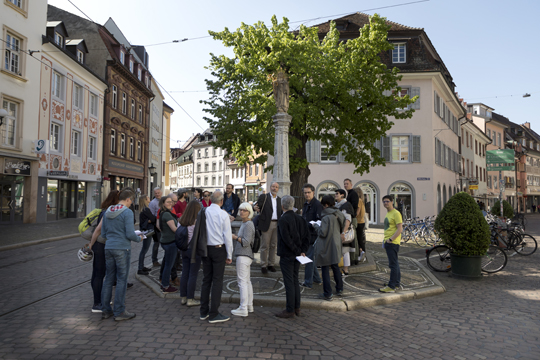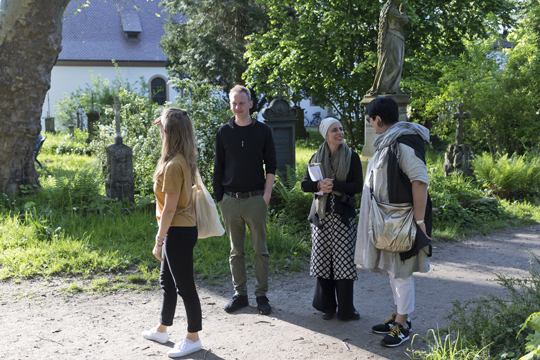On the trail of urban Leisure
Freiburg, May 23, 2019
First of all: it is of course completely absurd to make an appointment for a city tour about leisure on May 1 (Labor Day) of all days, while everyone else spends the day off work, doing nothing but relaxing and enjoying the good weather. But perhaps the secret model of the Collaborative Research Center “Otium. Boundaries, Chronotopes, Practices” is to explore what others have. Prof. Dr. Hans W. Hubert from the Kunstgeschichtliches Institut (Institute of Art History) at the University of Freiburg explained where leisure can be discovered during the city tour.
 The Oberlinden fountain is a construct from a time in which Freiburg’s mayor Otto Winterer worked toward the city’s Gothic reconstruction.
The Oberlinden fountain is a construct from a time in which Freiburg’s mayor Otto Winterer worked toward the city’s Gothic reconstruction.
Photo: Jürgen Gocke
On this day a remarkable group gathered at the Schwabentor to experience urban leisure in Freiburg. The assembled group is so large that the prepared readers from Prof. Dr. Hans W. Hubert, which he fishes from a linen bag with a sloth printed upon it, quickly run out. It is the emblem of the leisure magazine published by the Collaborative Research Centre “Otium. Boundaries, Chronotopes, Practices”. “The students chose it,” Hubert jokingly comments about the likeable mascot.
The tour he offers not only lures people in with his different approach to the city; it is also the opening event of the conference “Urban Leisure, Materialities, Practices, Representations,” which will begin on the following day. The fact that one can get into conversation with colleagues and get to know each other here without any compulsion is a thoroughly deliberate side effect.
Strolling like the French
Hubert, in addition to his knowledge of art history, explains his origins as a guide. Hubert is a Berliner. And didn’t Berlin produce with the writer Franz Hessel, the only German flâneur who could seriously take on the French poet Guillaume Apollinaire? Before the tour participants get moving, they take a quick look at the reader. A “greeting from the May 1st celebration” is depicted there. On the postcard, a young family postulates - the man holding the flag in one hand and a Marx portrait in the other – “8 hours of work/8 hours of leisure/8 hours of sleep.” Something could be learned from that!
But it should not be so difficult to learn leisure from Freiburg. In the late 19th century, the foundation of the Habsburgs was regarded as a city of pensioners. And who else could know more about leisure than those who already had left the rush hour of life behind them, were financially well secured and wanted to spend their last phase of life pleasantly?
 Time is not suspended in the Old Cemetery either. Photo: Jürgen Gocke
Time is not suspended in the Old Cemetery either. Photo: Jürgen Gocke
The manageable and idyllic, which still characterizes Freiburg today, is due to a clever image campaign. What appears medieval today was created multiple times in the 19th and early 20th centuries. The slightly meandering course of the Salzstrasse, which delights the eye with its many varied facades, transfers principles of visual axes and paths from garden architecture into urban space. The fact that the old town appears less monotonous and that smaller shops predominate is due to this small-scale parceling, which was also used for reconstruction after World War II.
The principle of going with the flow
Freiburg’s mayor Otto Winterer, Hubert later reports on the Oberlinden fountain, worked at the end of the 19th and beginning of the 20th century on the Gothic reconstruction of the city. The cathedral set the stylistic mood. Freiburg was to become the most beautiful city in Germany. The fountain at Oberlindenplatz is a construction from this time. From the Middle Ages, the lime tree was handed down as an important tree, insofar as justice was often spoken under it. But the fountain itself is not documented for medieval Freiburg. The combination of fountain and lime tree may seem authentic, but it is charged with literature and pictorial tradition.
The tour participants sit and stand relaxed at the Schwabentor. Their eyes turn to the left, where the water is fed into the canal system on the other side of the road. The brooks are arranged in the form of a rhombus and use the gradient of the city - at the end the water flows together again in Unterlinden. To walk idly can also simply mean to follow the water and the principle of drifting. That which became a kind of trademark of the old town had economic origins in the Middle Ages. The brooks supplied the crafts enterprises with water.
Freiburg was a trading town, and in 1120 it was granted market rights by Conrad I, Duke of Zähringen together with the town charter. If the participants look to the right, they see the Himmelsbach dry cleaner, which has had its headquarters in Gerberau since the beginning of the 20th century. In the Middle Ages there was a bath house here - also a place of leisure. In the cellar, Hubert tells us, there is a hydroelectric power plant to generate energy for operation or for the public power grid. Someone probably had time to think. Leisure is time that one can use in one way or another.
Sometimes leisure ends where it touches that of another
The group turns into Gerberau and has to avoid it first. The leisure of pedestrians is argumentatively inferior to that of convertible drivers. Sometimes leisure ends where it comes upon that of another. We pass the Augustinerplatz, where the residents perceive the leisure behavior of some as a noisey nuisance. We stroll in the direction of the cathedral, where the verses of old Reinhard Mey pop songs, infused with seemingly boundless freedom, breeze by. A short rest, and then the tour continues over smaller detours to the old cemetery, before the city tour heads for the chestnut garden on the Schlossberg.
“It would be great if we had time”, Hubert still says and points to the stock of old graves. And the monuments between the high grass sprinkled with isolated flowers, really are worth a closer look. But that is when the bell of the neighboring Ludwigskirche rings. Even in a cemetery, time is not suspended. For those who lie here, it has become irrelevant. And the living should understand it more often as leisure.
Annette Hoffmann

